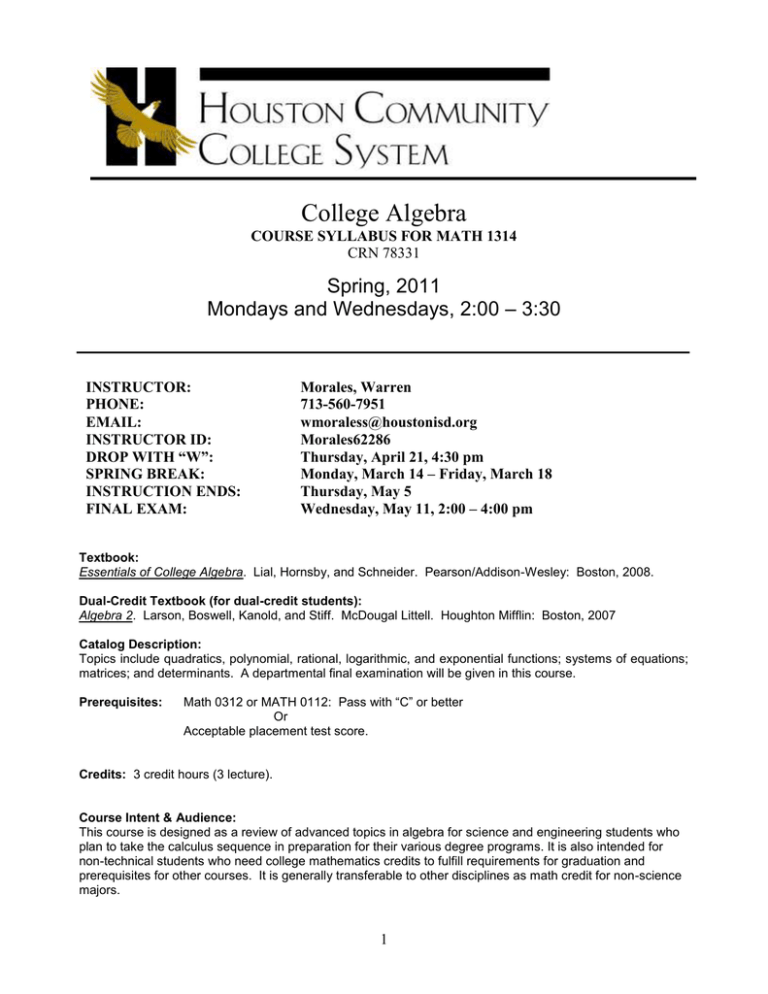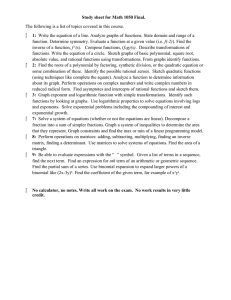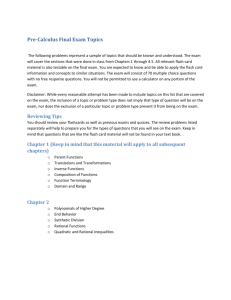
College Algebra
COURSE SYLLABUS FOR MATH 1314
CRN 78331
Spring, 2011
Mondays and Wednesdays, 2:00 – 3:30
INSTRUCTOR:
PHONE:
EMAIL:
INSTRUCTOR ID:
DROP WITH “W”:
SPRING BREAK:
INSTRUCTION ENDS:
FINAL EXAM:
Morales, Warren
713-560-7951
wmoraless@houstonisd.org
Morales62286
Thursday, April 21, 4:30 pm
Monday, March 14 – Friday, March 18
Thursday, May 5
Wednesday, May 11, 2:00 – 4:00 pm
Textbook:
Essentials of College Algebra. Lial, Hornsby, and Schneider. Pearson/Addison-Wesley: Boston, 2008.
Dual-Credit Textbook (for dual-credit students):
Algebra 2. Larson, Boswell, Kanold, and Stiff. McDougal Littell. Houghton Mifflin: Boston, 2007
Catalog Description:
Topics include quadratics, polynomial, rational, logarithmic, and exponential functions; systems of equations;
matrices; and determinants. A departmental final examination will be given in this course.
Prerequisites:
Math 0312 or MATH 0112: Pass with “C” or better
Or
Acceptable placement test score.
Credits: 3 credit hours (3 lecture).
Course Intent & Audience:
This course is designed as a review of advanced topics in algebra for science and engineering students who
plan to take the calculus sequence in preparation for their various degree programs. It is also intended for
non-technical students who need college mathematics credits to fulfill requirements for graduation and
prerequisites for other courses. It is generally transferable to other disciplines as math credit for non-science
majors.
1
Make-up policy:
Make-up exams will not be given unless the student provides a written medical note from a medical doctor
indicating the reason for the absence from the class. If a non-medical emergency arises, the student must
contact the instructor. In such cases, make-up exams will be decided on an individual basis.
Attendance policy:
Attendance is checked during every class. When you have accumulated 12.5 % or 11 hours of absences, the
instructor is obligated by law to drop you from the class.
Tardiness policy:
A student who is more than 30 minutes tardy to the class will be considered absent from the class.
Homework Policy: Students will be assigned homework from MyMathLab as well as problem sets from the
text. A homework grade will be issued at the end of the semester and will count the equivalent of one test
grade.
Grading policy: Your final course grade is based on the following standard HCCS scale.
Final Average
90 ≤ Avg ≤ 100
80 ≤ Avg < 90
70 ≤ Avg < 80
60 ≤ Avg < 70
Avg < 60
Final Course
Grade
A
B
C
D
F
For students receiving high school dual-credit, the following grade will be posted as the high school grade
equivalent: A = 95; B = 85; C = 77; D = 72; F = 60.
There will be five (5) in-class tests during the semester. Each test will be worth 100 points. Homework will be
done with MyMathLab and selected problems from the text. The homework grade will count as a major test
grade. The tests will be weighted as 75% of the total grade, and the final exam will be weighted as 25% of
the total grade.
Possible:
Test 1:
Test 2:
Test 3:
Test 4:
Test 5:
MML:
Total:
100
100
100
100
100
100
500
My Scores:
Test 1:
Test 2:
Test 3:
Test 4:
Test 5:
MML:
My Total:
_______________
_______________
_______________
_______________
_______________
_______________
_______________
Your Average = (Your Total) / 600
Final Average = 0.25*(Final Exam Score) + 0.75*(Your Average)
Final Examination:
The final examination is departmental and consists of 33 multiple-choice problems. The problems cover all
the material required in the course.
Withdrawal policy:
If you wish to drop the class, then it is your responsibility to do that before the final drop date. If your
name is on the roll at the end of the term, you WILL receive a grade. Neither you nor your instructor will
be able to perform the drop after the final drop date. Please refer to the following notice before dropping the
class.
NOTICE: Students who take a course three or more times will face significant tuition or
fee increases at HCC and other Texas public colleges and universities. In addition, state law
allows students a maximum of 6 course withdrawals during their entire college career. Students with
more than 6 drops will be required to pay additional fees. Prior to course withdrawal, you must
confer with your professor or counselor about your study habits, homework, test-taking skills,
attendance, course participation, and tutoring or other assistance that is available.
2
Calculators:
Students will use a TI-83 graphing calculator during the semester and on some tests. The final exam is a
non-calculator exam.
Student conduct:
Students should not engage in disruptive activities while in the classroom. Any conduct that is deemed
detrimental to the academic atmosphere, such as cell phone use or consistently talking during instructional
delivery, will not be tolerated. Any student found guilty of such conduct will be asked to leave the classroom
until further notice.
Electronic devices:
As a student active in the learning community of this course, it is your responsibility to be respectful of the
learning atmosphere in the classroom. To show respect to your fellow classmates as well as your instructor,
you will turn off your phone and any other electronic device and will not use these devices in the classroom
unless you receive permission from the instructor.
Academic dishonesty:
All students are required to exercise academic honesty in completion of all tests and assignments. Penalties
for academic dishonesty (cheating on a test, collusion on an assignment, etc.) include, but are not limited to, a
reduced grade, a “0” on that test or assignment, a “W” in the course, or an “F” in the course. The use of
recording devices, including camera phones and tape recorders, is prohibited in all locations where
instruction, tutoring, or testing occurs. Students with disabilities who need to use a recording device as a
reasonable accommodation should contact the Disability Services Office for information.
Resources and supplemental instruction:
Any student enrolled in Math 1314 at HCC has access to the tutoring labs where one-on-one help is available.
The math tutoring labs are staffed with student assistants who can aid students with math problems and offer
help with . Please check with your instructor for the hours of the tutoring labs. In addition, free online tutoring
is provided. For more information about tutoring, go to the math department web page and select the tutoring
link. Another helpful resource is the student solutions manual that may be obtained from the bookstore.
Students with Disabilities:
Any student with a documented disability (e.g. physical, learning, psychiatric, vision, hearing, etc.) who needs
to arrange reasonable accommodations must contact the Disability Support Services Office at this college at
the beginning of the semester. To make an appointment, please call 713-718-7910. Professors are
authorized to provide only the accommodations requested by the Disability Support Office.
Course Objectives:
At the completion of this course, a student should be able to:
1. Solve quadratic equations in one variable by factoring, using the square root property, completing the
square, and using the quadratic formula.
2. Find the distance and midpoint between two points in the Cartesian plane.
3. Solve radical equations, fractional equations, and equations of quadratic form.
4. Recognize the equation of a straight line, graph the equation of a straight line, find the slope and
intercepts of a line, know the relationship between the slopes of parallel and perpendicular lines, and be
able to determine the equation of a line from information such as two points on the line, or one point on
the line and the slope of the line.
5. Know the definition of a function, determine the domain and range of a function, evaluate expressions
involving functional notation, simplify expressions involving the algebra of functions, graph functions by
plotting points, know the definition of inverse functions, and given a function find its inverse.
6. Graph linear functions, quadratic functions, piecewise-defined functions, absolute value functions,
polynomial functions, rational functions, exponential functions, and logarithmic functions.
7. Solve linear inequalities and linear equations involving absolute value, state the solution in interval
notation, and graph the solution.
8. Solve non-linear (quadratic and rational) inequalities, state the solution in interval notation, and graph the
solution.
9. Understand vertical and horizontal shifts, stretching, shrinking, and reflections of graphs of functions.
10. Recognize the equation of a circle, sketch the graph of a circle, and find the equation of a circle.
3
11.
12.
13.
14.
15.
Determine the rational zeros of a polynomial.
Understand the inverse relationship between the exponential and logarithmic functions.
Solve exponential and logarithmic equations.
Solve problems involving variation.
Perform operations with matrices, and find the determinants of matrices.
GENERAL GRADING RUBRIC:
In free-response questions on a test, problems will be worth 3, 4 or 5 points. The rubric for grading is given
below.
Meaning
Out of 3
Out of 4
Superior
3
4
Out of
5
5
3
4
Satisfactory
Satisfactory,
With
Minor Flaws
2
2
3
Satisfactory,
With
Major Flaws
1
1
2
Unsatisfactory
0
0
0–1
Student shows understanding of the concept by:
Having fewer than 2 minor errors
Providing a clear, logical and complete
process
Providing evidence of checking and/or alternate
representation
Using creative, appropriate strategies
Exceeding the minimum requirements of the
task
Student shows understanding of the concept by:
Having 2 to 3 minor errors, but correct process
Providing a logical and complete process but
lacking clarity
Using appropriate strategies
Satisfying the requirements of the task
Student shows understanding of the concept by:
Using appropriate strategies
Showing work, but process haphazard
Writing an explanation that is mainly clear, but
may show some gaps
Satisfying some elements of the task
Student shows rudimentary understanding of the
concept by:
Providing haphazard, illogical, or unclear work
Not checking work
Writing an explanation that did not connect to
the problem or the solution
Answering only (without supporting work)
Satisfying few elements of the task
Student shows little or no understanding of the
concept by:
Attempting the problem, but no idea
Not using a recognizable process
Calculating incorrectly
Using inappropriate charts and graphs
Satisfying no elements of the task
4
Course Schedule (Topics will be covered in the order presented here)
Unit 1 - Equations and Inequalities
1.4 Quadratic Equations
1/21 (F), 1/24 (M)
1.5 Applications and Modeling with Quadratic Equations
1/26 (W)
R.5 Rational Expressions
1/26 (W)
1.6 Other Types of Equations
1/31 (M)
1.7 Inequalities
Independent Work
1.8 Absolute Value Equations and Inequalities
2/2 (W)
R.3 Review Rules of Exponents
2/4 (F)
Unit 2 - Graphs and Functions
2.1 Graphs of Equations
Independent Work
2.2 Functions
Independent Work
2.3 Linear Functions
Independent Work
2.4 Equations of Lines; Curve Fitting
Independent Work
2.5 Graphs of Basic Functions
2/7 (M)
2.6 Graphing Techniques
2/14 (M)
2.7 Function Operations and Composition
2/16 (W)
3.6 Variation
2/19 (F)
5.1 Systems of Linear Equations
Independent Work
Unit 3 - Polynomial and Rational Functions
3.1 Quadratic Functions and Models
2/21 (M)
3.2 Synthetic Division
2/23 (W)
3.3 Zeros of Polynomial Functions
3/2 (W)
3.4 Polynomial Functions: Graphs, Applications, and Models
3/7(M)
3.5 Rational Functions: Graphs, Applications, and Models
3/9 (W)
Unit 4 - Exponential and Logarithmic Functions
4.1 Inverse Functions
3/11 (F)
4.2 Exponential Functions
3/21 (M)
4.3 Logarithmic Functions
3/23 (W)
4.4 Evaluating Logarithms
3/28 (M)
4.5 Exponential and Logarithmic Equations
3/30 (W)
4.6 Applications & Models of Exponential Growth & Decay
4/1 (M), 4/6 (W)
Unit 5 - Systems and Matrices
5.5 Nonlinear Systems of Equations
4/11 (M)
5.3 Determinants
4/13 (W)
5.7 Properties of Matrices
4/18 (M)
5
Test Schedule:
Test
Units Covered on Test
Date
Test #1
Radicals and Complex Numbers
Monday, 1/19
Test #2
1.4, 1.5, 1.6, 1.7, 1.8, 2.1, 2.2, 2.3, 2.4, R.3,
R.5
Wednesday, 2/9
Test #3
2.5, 2.6, 2.7, 3.1, 3.2, 3.6, 5.1
Monday, 2/28
Test #4
3.3, 3.4, 3.5, 4.1, 4.2, 4.3, 4.4
Monday, 4/4
Test #5
4.5, 4.6, 5.3, 5.5, 5.7
Monday, 5/2
Final Exam
Comprehensive
Wednesday, 5/11, 2 – 4 pm
Section Number Due Date
1.4
01/31/11
1.5
01/31/11
1.6
02/07/11
1.7
02/07/11
1.8
02/07/11
2.1
02/08/11
2.2
02/08/11
2.3
02/08/11
2.4
02/08/11
2.5
02/21/11
2.6
02/21/11
2.7
02/21/11
3.6
02/27/11
5.1
02/27/11
3.1
02/27/11
3.2
02/27/11
3.3
03/07/11
3.4
03/21/11
3.5
03/21/11
4.1
03/21/11
4.2
03/28/11
4.3
03/28/11
4.4
04/03/11
4.5
04/05/11
4.6
04/08/11
5.3
04/18/11
5.5
04/18/11
5.7
04/21/11
6




